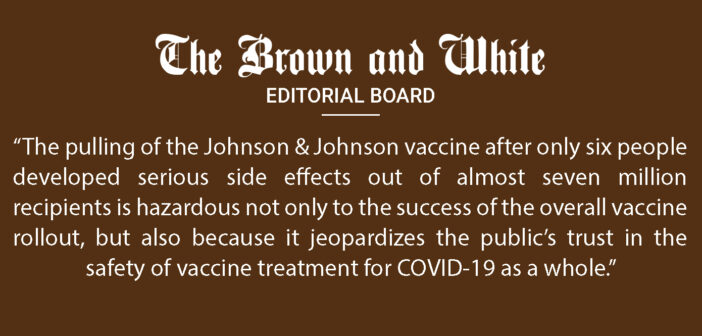On April 13, the Centers for Disease Control and Prevention recommended a pause in the use of the Johnson & Johnson single dose COVID-19 vaccine after six people who were administered the vaccine developed blood clots.
These six cases all shared a type of blood clot called cerebral venous sinus thrombosis, which was seen in combination with low levels of blood platelets, and all occured in women ages between 18 and 38.
As of April 12, 6.8 million doses of the Johnson & Johnson vaccine have been administered before the CDC has recommended the pause in distribution.
The pulling of the Johnson & Johnson vaccine after only six people developed serious side effects out of almost seven million recipients is hazardous not only to the success of the overall vaccine rollout, but also because it jeopardizes the public’s trust in the safety of vaccine treatment for COVID-19 as a whole.
Many drugs that people take on a daily basis are also approved by the Food and Drug Administration, but have a multitude of significant, commonly endured side effects.
Hormonal birth control has a 0.5 to 1.2 percent risk of causing blood clots. Cigarette smoking has a 0.18 percent chance of causing blood clots. And a COVID-19 infection, 16.5 percent.
The Johnson & Johnson vaccine risk of causing blood clots sits at 0.000088 percent.
Diabetes medications, over-the-counter painkillers, fluoroquinolone antibiotics, and a slew of other FDA approved drugs have increasingly serious side effects and have caused permanent, sometimes fatal, damages.
How the news of this was circulated across the media also poses a threat to the success of vaccine distribution.
A sad truth is that most news consumers do not read entire news stories. According to a study done by the American Press Institute, four in 10 journalists think consumers rarely read past the headline.
With that being said, it then places significant importance on how headlines are written because it is more likely than not that consumers will absorb what’s written in a headline and not much else.
News stories about the pulling of the Johnson & Johnson vaccine had headlines stating that the vaccine is being pulled out of circulation because it causes blood clots or is a threat to safety.
While these statements have unfortunately proven true for six individuals, major news networks perpetuate the idea that the vaccines are not trustworthy and make people question their efficacy and safety.
Only six people out of 6.8 million who received the Johnson & Johnson vaccine developed blood clots.
News media corporations have the tendency to unnecessarily negatively frame stories in their headlines to build readership.
CNN, for example, in their article about vaccine efficacy, wrote in their headline and lede that 5,800 people still became infected with COVID-19 out of the several million who had been vaccinated. Instead of focusing on the fact that the vaccines have been more effective than anticipated, the reporter opted to negatively frame statistics that have been victories in the fight against COVID-19.
The Johnson & Johnson vaccine is incredibly crucial to the speed of the vaccine rollout, but headlines like these validate those who fuel distrust of the COVID-19 vaccine, and push us away from achieving herd immunity from this virus.
Over half a million people have died from COVID-19 in the U.S. alone. Over 3 million have died across the world. These vaccines are crucial to saving lives and bringing us closer to the end of this pandemic, but that is only going to be achieved if major media outlets stop fueling distrust in medicine.
We as journalists have the obligation to truthfully report the news, and the truth is that the vaccines are working, less people are getting infected and,most importantly, less people are dying. Let’s not make it seem otherwise just to get more clicks on a story.
Not only do journalists owe a responsibility to their readers to report as accurately and objectively as possible, they owe it to their readers to frame stories accurately. Even when reporting properly, poor framing can be as consequential as misrepresenting the facts and in this case, misrepresentation might just be a matter of life and death.






Comment policy
Comments posted to The Brown and White website are reviewed by a moderator before being approved. Incendiary speech or harassing language, including comments targeted at individuals, may be deemed unacceptable and not published. Spam and other soliciting will also be declined.
The Brown and White also reserves the right to not publish entirely anonymous comments.